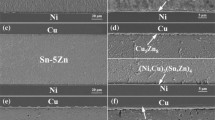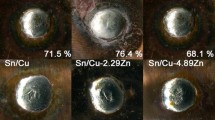Abstract
Sn-20.0 wt%In (Sn-20.0In) alloy is a promising base material in Pb-free solders for low-temperature applications. Zn is often used as an additive to Pb-free solders to reduce the extent of undercooling during reflow. Cu is the most commonly used substrate in electronics industry. Interfacial stability at Sn–In–Zn/Cu joints is crucial to reliability of electronic products. In this study, interfacial reactions between Sn-20.0 wt%In-x wt%Zn (Sn-20.0In-xZn) solders and Cu where x = 0.5, 0.7, 1.0, 2.0, 3.0, and 5.0 at 150, 230, and 260 °C were experimentally examined. It is found that the reaction phase formation and interfacial morphologies are strongly influenced by Zn concentrations. The reaction phases evolve from the Cu6Sn5 phase, CuZn and Cu5Zn8 phase, to Cu5Zn8 phase with higher Zn doping in the solders. The Cu5Zn8 phase acted as a diffusion barrier and suppressed the growth of the Cu6Sn5 phase. The results indicate that 2.0 wt%Zn addition resulted in the gentlest reactions during both soldering and solid-state ageing in Sn-20.0In-xZn/Cu couples.









Similar content being viewed by others
References
Suganuma K (2001) Advances in lead-free electronics soldering. Curr Opin Solid State Mater Sci 5:55–64
Chen S-W, Wang C-H, Lin S-K, Chiu C-N (2007) Phase diagrams of Pb-free solders and their related materials systems. J Mater Sci 18:19. doi:10.1007/s10854-006-9010-x
The Restriction of Hazardous Substances in Electrical and Electronic Equipment (ROHS), Official Journal of the European Union: L 37/19-L 37/23
Abtew M, Selvaduray G (2000) Lead-free solders in microelectronics. Mat Sci Eng R 27:95–141
Zeng K, Tu KN (2002) Six cases of reliability study of Pb-free solder joints in electronic packaging technology. Mat Sci Eng R 38:55–105
Laurila T, Vuorinen V, Kivilahti JK (2005) Interfacial reactions between lead-free solders and common base materials. Mat Sci Eng R 49:1–60
Lin S-K, Yang C-F, Wu S-H, Chen S-W (2008) Liquidus projection and solidification of the Sn–In–Cu ternary alloys. J Electron Mater 37:498–506
Chen S-W, Lin S-K (2006) Electric current-induced abnormal Cu/gamma-InSn4 interfacial reactions. J Mater Res 21:3065–3071
Lin S-K, Chen S-W (2006) Interfacial reactions in the Sn-20 at.% In/Cu and Sn-20 at.% In/Ni couples at 160 degrees C. J Mater Res 21:1712–1717
Chen S-W, Lin S-K (2006) Effects of temperature on interfacial reactions in gamma-InSn4/Ni couples. J Mater Res 21:1161–1166
Huang C-Y, Chen S-W (2002) Interfacial reactions in In–Sn/Ni couples and phase equilibria of the In–Sn–Ni system. J Electron Mater 31:152–160
Lee CC, Choe S (2002) Fluxless In–Sn bonding process at 140 degrees C. Mater Sci Eng A 333:45–50
Chen S-W, Hsu C-W, Lin S-K, Hsu C-M (2013) Reaction evolution in Sn-20.0 wt% In-2.8 wt% Ag/Ni couples. J Mater Res 28:3257–3260
Lin S-K, Hsu C-W, Chen S-W, Hsu C-M (2013) Interfacial reactions in Sn-20In-2.8Ag/Cu couples. Mater Chem Phys 142:268–275
Jee YK, Ko YH, Yu J (2007) Effect of Zn on the intermetallics formation and reliability of Sn-3.5Ag solder on a Cu pad. J Mater Res 22:1879–1887
Cho MG, Kang SK, Shih DY, Lee HM (2007) Effects of minor additions of Zn on interfacial reactions of Sn–Ag–Cu and Sn–Cu solders with various Cu substrates during thermal aging. J Electron Mater 36:1501–1509
Lin S-K, Chung T-Y, Chen S-W, Chang C-H (2009) 250 degrees C isothermal section of ternary Sn–In–Cu phase equilibria. J Mater Res 24:2628–2637
Chou C-Y, Chen S-W (2006) Phase equilibria of the Sn–Zn–Cu ternary system. Acta Mater 54:2393–2400
Miodownik AP (1990) Cu–Zn. In: Massalski TB, Okamoto H (eds) Binary alloy phase diagrams, 2nd edn. ASM International, Materials Park, pp 1508–1510
Duan LL, Yu DQ, Han SQ, Ma HT, Wang L (2004) Microstructural evolution of Sn-9Zn-3Bi solder/Cu joint during long-term aging at 170 degrees C. J Alloy Compd 381:202–207
Yang SC, Ho CE, Chang CW, Kao CR (2006) Strong Zn concentration effect on the soldering reactions between Sn-based solders and Cu. J Mater Res 21:2436–2439
Kotadia HR, Mokhtari O, Clode MP, Green MA, Mannan SH (2012) Intermetallic compound growth suppression at high temperature in SAC solders with Zn addition on Cu and Ni–P substrates. J Alloy Compd 511:176–188
Acknowledgements
The authors acknowledge the financial support of National Science Council of Taiwan (NSC97-2221-E-007-067-MY3).
Author information
Authors and Affiliations
Corresponding author
Rights and permissions
About this article
Cite this article
Lin, SK., Chang, RB., Chen, SW. et al. Effects of zinc on the interfacial reactions of tin–indium solder joints with copper. J Mater Sci 49, 3805–3815 (2014). https://doi.org/10.1007/s10853-014-8092-8
Received:
Accepted:
Published:
Issue Date:
DOI: https://doi.org/10.1007/s10853-014-8092-8




